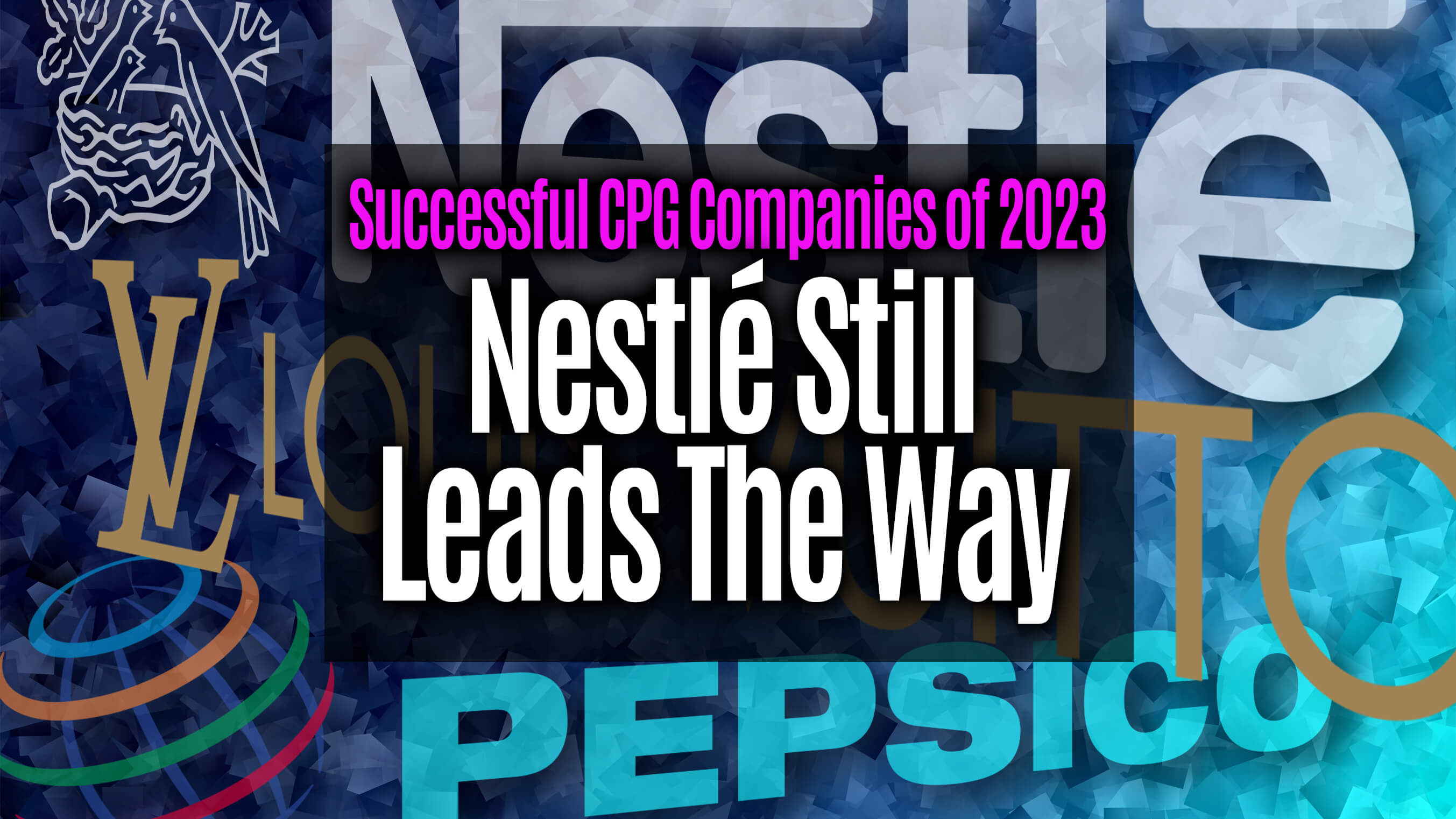
The broad category of products that most of us use daily is Consumer Packaged Goods or CPGs. We get them from retail stores or shop for them online and bring them into our homes and businesses.
Typically, these items don't sit around unopened for very long. We use one or more of them every day.
Chances are we'll run out of them at least once a week, and on the next shopping trip, we'll replenish our supply.
These individually packaged units fall into many classifications but share many key characteristics.
In this primer, we'll cover all things CPG and give examples of how creative and consistent branding support makes these packaged goods popular with consumers and profitable for companies.
This article include:
• 2023 Consumer Products Goods Performance
• Successful CPG Companies use Brand Support Services
CPG Definition and Examples
The broad term "packaged goods" refers to items sold in custom packaging meant to protect, preserve, and contain the contents.
Protection and containment are required for transportation and storage activities after manufacturing.
Preservation refers to extending the contents' shelf life, such as food and beverages or over-the-counter medicines and beauty products.
We also consider preservation/protection regarding tampering and theft prevention during transport and once the products are placed on retail shelves.
Many items are not meant for children, so the packaging will need unique tamper-proof designs to prevent injury, sickness, or death due to unauthorized access and usage.
We purchase consumer goods in individually packaged units or in various levels of bulk. On the shelves, depending on the item, you might see 2-packs, 3-packs, 10-packs, or an entire case.
Pricing typically will decrease as the number of units inside the package increases. You'll see various types of bulk packaging, from basic shrink-wrap designs to more elaborate custom-built systems meant for specific seasonal promotions and retail aisle placement.
CPG Categories
You can think of consumer goods in terms of four primary classifications. Of course, one could argue certain items may easily slot into more than one broad category, and that’s ok.
For this primer, we’ll go with the following non-exhaustive breakdowns:
- Personal Toiletries/Wellness/Beauty: Hair gels, shampoo, soap bars, body washes, deodorants, skin lotions, balms, lipstick, toothpaste, vitamin supplements, perfume and colognes, shaving supplies etc.
- Household Support Products: Dish and laundry detergent, window cleaners, drain cleaner, oven degreasing solutions, spray paint and thinners, markers and erasers, paper towels and toilet paper, etc.
- Food, Beverages, and Snacks: These are significant portions of CPG because of the preservation and limited shelf-life factors. Some prominent examples are canned and bottled beverages, condiments, cereals, snacks such as chips and candy, or dairy-sourced items like cheese and yogurt. Microwavable foods are a significant segment, using a wide array of packaging, including plastic cups or paper-based trays with shrink-wrap seals.
- Wearables are probably less prominent than food & beverage. However, many clothing lines are still presented in easily recognizable and branded packages. For example, signature sneakers and shoes celebrities endorse come in luxurious presentations to elevate perceived status. Modern wearable items like smartwatches, phones, headphones, and earpieces also bring their own luxury packaging to the forefront for preservation and creating special memories through the unboxing experience.
CPG Characteristics
We’ve shown that consumer goods span across many categories and use cases. They also have commonalities concerning their retail performance and other characteristics.
They generally have a lower average cost to the consumer compared to bigger ticket items such as a lawn mower or a new computer desk.
Durable goods like these cost more on average and remain on display longer since people don't research, purchase, or replace items like furniture, ovens, and dishwashers as often as a bottle of ketchup or a shrink-wrapped bulk supply of mineral water.
CPGs have higher turnover rates, as one might expect. Because they are used more frequently and cost less than durables, retailers consistently repeat orders and restock consumer product goods as inventory is consumed.
Orders for dairy products are likely to be filled at least weekly and more frequently in large metropolitan areas.
It's a competitive battlefield as well. If an item is sold out, many consumers have no issues choosing a competing national brand name or even a generic option with less brand recognition.
2023 Consumer Product Goods Performance
Having defined this industry and market, let's take a brief overview of their recent performance and highlight the top 3 CPG names for 2023;
- Retaining the #1 spot based on annual revenue is Nestlé SA, posting $99.3 billion.
- PepsiCo also retained their #2 rank, scoring $86.3 billion.
- LVMH Moët Hennessy Louis Vuitton improved their previous rank by five positions, posting revenue of $84.6 billion.

It’s easy to see how Nestlé SA repeated as the revenue leader; they are a CPG behemoth with an extensive portfolio of sub-brands dominating a wide range of product categories.
Nestlé SA beverage lines include mineral waters such as Perrier and S. Pellegrino, plus coffee beverage brands including Nestea and Coffee-Mate.
The name Purina is synonymous with the pet care industry, as is Gerber in the baby food market. Frozen food leaders Stouffer’s, Lean Cuisine, and Häagen-Dazs are all members of the Nestlé SA empire.
Their dairy footprint is equally impressive, with names including Carnation, Nesquik, and Dreyer's. Candy and snack fans likely have consumed their fair share of Nestlé SA products, including Kit Kat, Butterfinger, and Rolo candies.
While not an exhaustive list, Nestlé SA and similar organizations consistently rank at or near the top of major CPG distributor rankings.
See every company owned by Nestlé by Clicking Here!
By offering high-quality products across a wide range of categories that consumers actively source. The other reason is through expert Branding Support Services, which we'll cover below.
Successful CPG Companies use Brand Support Services
To ensure success, companies need to actively engage in efforts to develop, maintain, and enhance their brand identities.
These programs are crucial to how consumers perceive a company and the quality of its products. We refer to these systems as Branding Support Services (BSS). We can break down BSS into several activities.
Brand Strategy - This effort includes establishing or reinventing the company's identity and positioning within a given market. It defines how the organization differentiates itself from competitors and develops its target audience.
Logos & Graphics - The visual elements associated with a company, such as logos, fonts, and color palettes, all play considerable roles in representing the brand to the public. The way buyers recognize and remember a company and its products often begins with aesthetically pleasing typography, phrasing, and color choices. These characteristics also help products stand out on crowded, competitive retail shelves and e-commerce ads.
Copywriting & Messaging - Compelling copy is essential to creating the language and tones that hopefully resonate with consumers and align with the brand's mission.
Digital Branding - Replicating the above efforts across the many digital platforms and communities is crucial to reaching everyone, but especially younger generations who spend the majority of their days online in some capacity.
According to Gallup, 51% of teens spend nearly five hours per day on a social media platform. Clearly, if you want to market to teens and young adults, a branding support program must include a well-defined and executed digital strategy.
Physical Branding Materials - Physical product packaging with a look and feel aligned with your brand, colors, and text copy is essential in cultivating how consumers recall your company's name, identity, and products.
This also applies to promotional materials, including business cards, employee apparel, vehicle wraps, paint schemes, and promotional material designs.
Rebranding Efforts - Long-established companies often need to refresh their brand's identity. Perhaps the market has shifted, demographics have changed, or new competitors have emerged. Rebranding entails a new approach, fresh market analysis, and a detailed overhaul of everything related to a company's identity and message.
Brand Training - Ensuring your employees understand the message and identity of your organization is crucial to projecting your values to the market, especially in service industries where your staff frequently interact with the public in retail settings.
Legal Support - To protect your brand from unauthorized representation and use by competitors, a solid understanding and implementation of the trademark process in your region is crucial.
You'll need due diligence in researching domain names, licensing, and intellectual property matters. These efforts help safeguard your brand investments and prevent unintended infringement while maintaining exclusivity in the marketplace.
Next Level CPG Success
When you’re ready to level up with expert Branding Support Services, contact Catalpha Packaging, the leader in product packaging design, custom package printing, and point-of-purchase (POP) displays.
We’ll help you sell more of your products through superior package designs. We’ve helped CPG companies like yours increase sales in industries including pet supply, health & beauty, food & beverage, and cosmetics.
If you need assistance with merchandising and displaying your products, we've got you covered. We help you get your products noticed inside retail establishments and trade shows.
We are the leader in custom corrugate display solutions. Catalpha will create a winning packaging and brand support strategy for your product. Learn more about our branding services and contact our team of branding support and custom packaging experts today.

